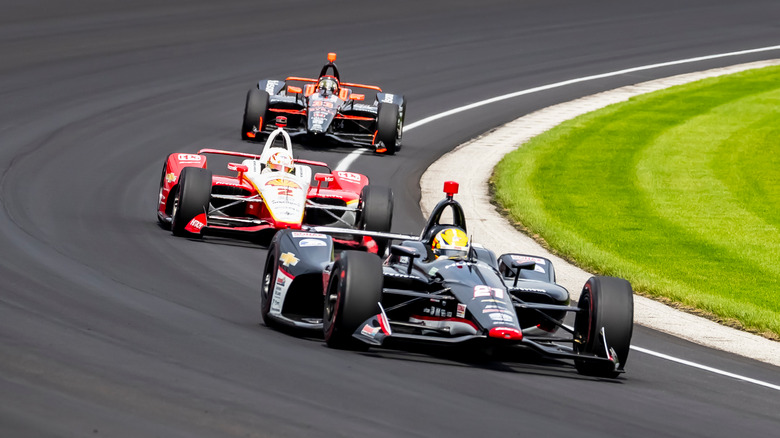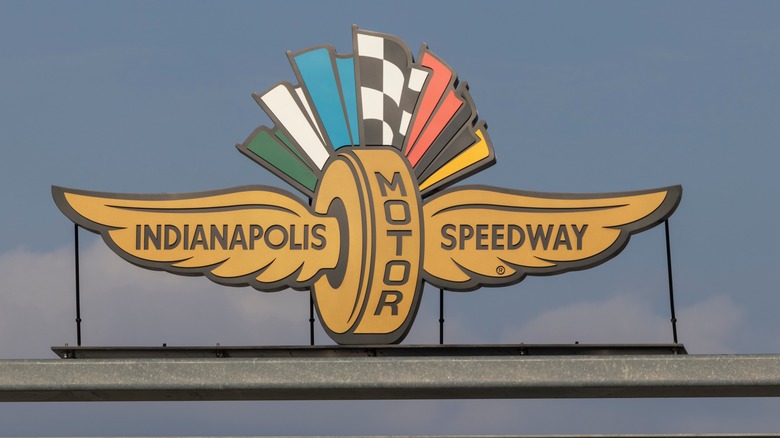This Was The First Person To Die At The Indy 500
One of America's marquee auto-racing events, the Indy 500 happens each Sunday of Memorial Day weekend at the Indianapolis Motor Speedway in Indianapolis, Indiana. Indy cars — like F1 race cars with no power steering, among a few other differences — reach speeds in excess of 200 mph (via Car Throttle). Needless to say, it's dangerous to travel that fast, even with highly-experienced motorsports athletes behind the wheel. For this reason, among others, scores of people have died at the raceway since it opened in 1909, at the Indy 500, and at other competitions. Most were racing-related casualties, IndyStar reports.
The first person to die at the Indy 500 was Sam Dickson, a riding mechanic, the first year the Indy 500 happened in 1911, the IndyStar elsewhere notes. Then as now, at the Indy 500, cars race 200 laps around the track for a total of 500 miles, and the competition typically lasts around three hours. In Dickson's day, top racing speeds were much less than 200 mph, averaging around 75 mph, (via The Henry Ford website). Still, with far fewer safety precautions in place than there are today, even a mechanical issue with the car Dickson rode in caused the wreck, and he died instantly. Details of Dickson's death show just how dangerous car racing can be.
The accident happened on lap 12
On lap 12 of the inaugural Indy 500, Sam Dickson, a riding mechanic, and driver Arthur Greiner were thrown from the car when the front wheel came off, causing Greiner to lose control. Dickson flew 20 feet from where the accident happened, hit a fence, and was pronounced dead on the scene. ESPN says the first race car driver to install a seatbelt didn't do so until 1922 because early on it was thought a person had a better chance of survival if ejected from the car than if they were trapped inside a burning vehicle. Several others were injured in the wreck, The New York Times reported that year. The crowd reportedly swarmed the areas where Dickson landed and had to be pushed back by security before medical help could arrive. Footage of the first Indy 500 can be seen above.
As for Greiner, he was knocked unconscious and suffered a broken arm but he survived the wreck. Greiner's mental and physical well-being declined after the tragedy, and he died a few short years later in a Chicago sanitarium in 1916 after an attempt on his own life and his wife's in an episode of violent unraveling, possibly related to chronic back pain, according to OldRacingsCars.com. Notably, Ray Harroun, who won the inaugural Indy 500, had no driving mechanic; he used a rearview mirror, instead. From there, 21 fatalities happened at the Indianapolis 500 throughout the 1930s, the most in history, Fox News reports.
Riding mechanics are no longer used
The dangers of race car driving aside, if Sam Dickson were at the Indy 500 today, he might not have died. As mentioned, Dickson, the first person to die at the raceway, was a riding mechanic, not a driver. That position was just as it sounds: A mechanic who rode along with the driver to help fix mechanical issues should they arise mid-race, to keep an eye on others in the race so the driver didn't have to, and to keep contact with the pit crew through hand signals, among other tasks.
Throughout most of car racing history riding mechanics were optional, though they were required in the U.S. from 1930 to 1937 and were common in Dickson's day. By the mid-1920s, the inherent danger of two people in the car led to a riding mechanic ban in Europe, according to Motorsport Magazine. Besides Dickson's tragic death, in the history of the Indy 500, 11 riding mechanics died during races or practice, or while qualifying. The last one, Babe Stapp, died in 1939 in a tire-testing mishap.

